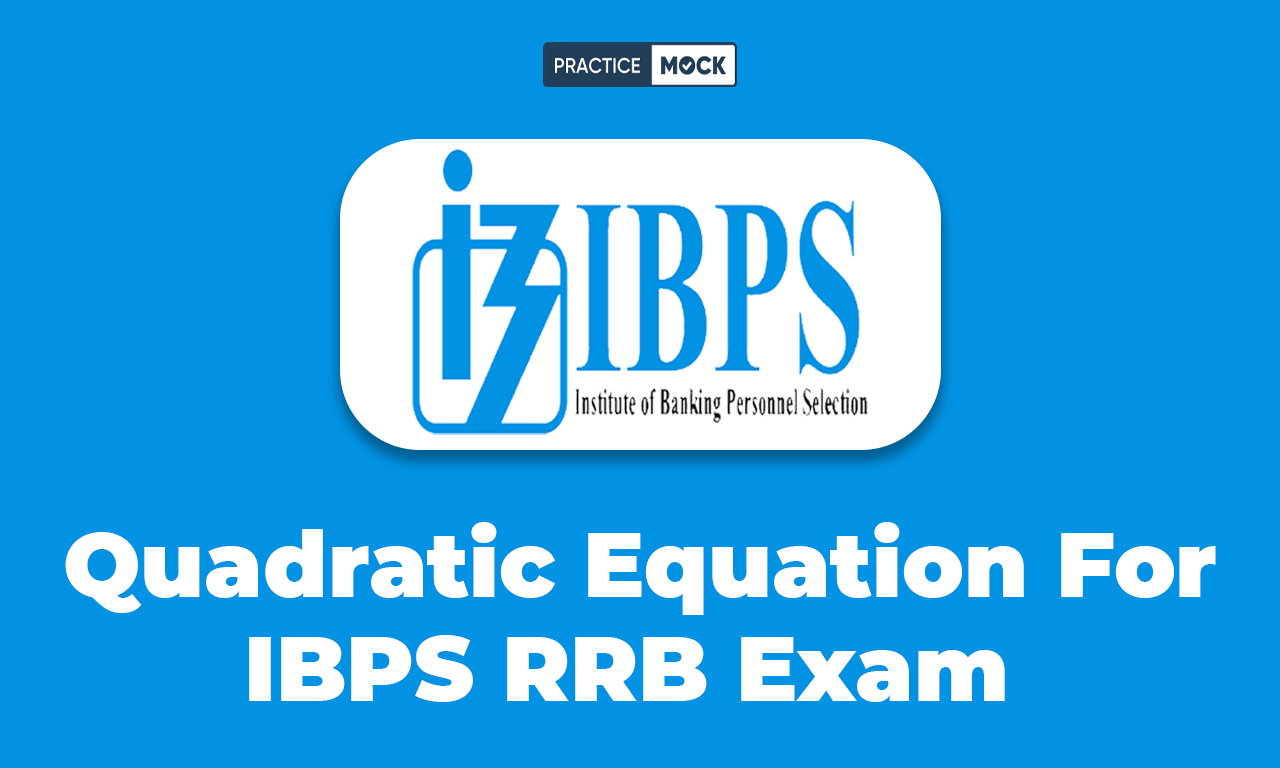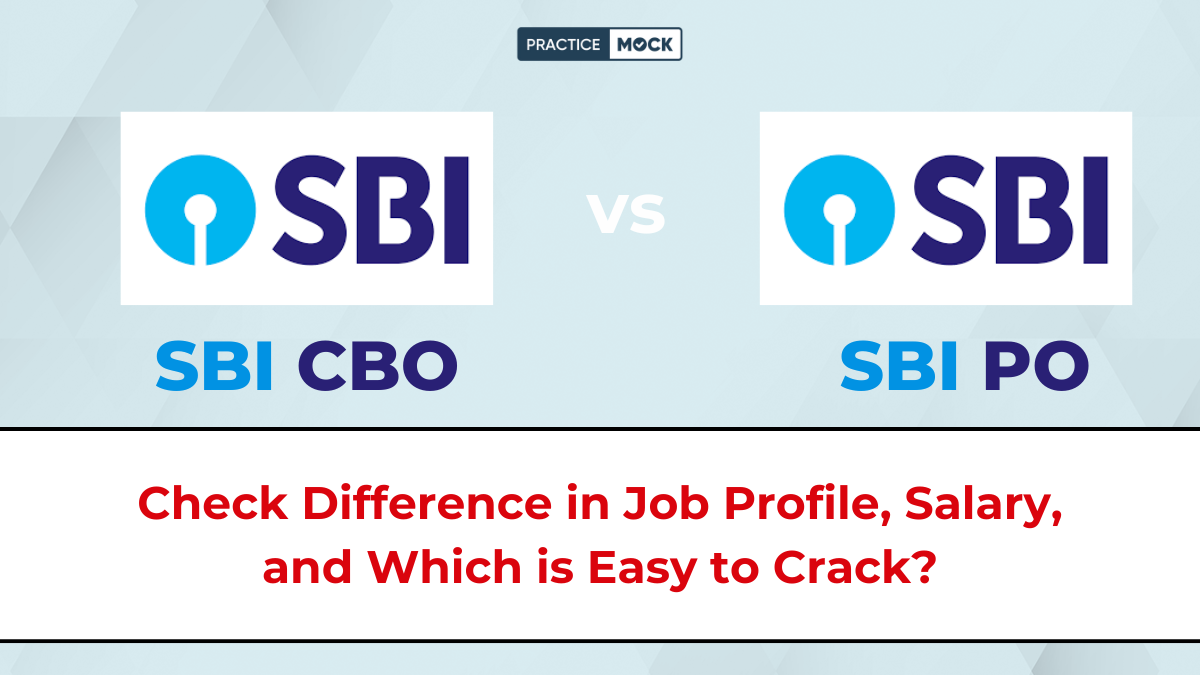Quadratic Equation For IBPS RRB Exam, Check Important Question


Quadratic Equation for IBPS RRB Exam- The topic of quadratic equations is a crucial part of the quantitative aptitude section in various competitive exams, including the IBPS RRB exam and other banking exams. Here we are going to discuss a few Quant Quadratic Equation Practice Questions for the Prelims Exam. These questions will be helpful for the upcoming IBPS RRB 2024 Exam. Though it is one of the trickiest topics from this section, these can be solved with constant practice which is why we are here with these practice questions along with their answers and detailed solutions. Mastering these equations is essential for scoring well in this section. Candidates check all details in the article below.
What is a Quadratic Equation?
A quadratic equation is a second-degree polynomial equation in one variable of the form:
ax² + bx + c = 0
where a, b and c are constants, and the x is variable. The x represents the unknown quantity, and the constants a, b and c determine the shape and nature of the equation.
Important Question for Quadratic Equation
Question 1: In the question, two equations I and II are given. You have to solve both the equations to establish the correct relation between x and y and choose the correct option.
I. 3x2 – 24x + 36 = 0
II. 4y2 = y + 5
A) x > y
B) x < y
C) x = y or the relationship cannot be established
D) x ≥ y
E) x ≤ y
Question 2: In the question, two equations I and II are given. You have to solve both the equations to establish the correct relation between x and y and choose the correct option.
I. x2 – 2x – 63 = 0
II. y2 + 14y + 48 = 0
A) x > y
B) x < y
C) x = y or the relationship cannot be established
D) x ≥ y
E) x ≤ y
Question 3: In the question, two equations I and II are given. You have to solve both the equations to establish the correct relation between x and y and choose the correct option.
I. x2 + 15x + 54 = 0
II. y2 + 20y + 99 = 0
A) x > y
B) x < y
C) x = y or the relationship cannot be established
D) x ≥ y
E) x ≤ y
Question 4: In the question, two equations I and II are given. You have to solve both the equations to establish the correct relation between x and y and choose the correct option.
I. 3x + 7y = 53
II. 7x – 5y = 17
A) x > y
B) x < y
C) x = y or the relationship cannot be established
D) x ≥ y
E) x ≤ y
Question 5: In the question, two equations I and II are given. You have to solve both the equations to establish the correct relation between x and y and choose the correct option.
I. x2 – 27x + 180 = 0
II. y2 – 24y + 140 = 0
A) x > y
B) x < y
C) x = y or the relationship cannot be established
D) x ≥ y
E) x ≤ y
Question 6: In the question, two equations I and II are given. You have to solve both the equations to establish the correct relation between x and y and choose the correct option.
I. x2 – 11x + 30 = 0
II. y2 – 11y + 18 = 0
A) x > y
B) x < y
C) x = y or the relationship cannot be established
D) x ≥ y
E) x ≤ y
Question 7: In the question, two equations I and II are given. You have to solve both the equations to establish the correct relation between x and y and choose the correct option.
I. x2 + 3x – 10 = 0
II. y2 – 5y + 6 = 0
A) x > y
B) x < y
C) x = y or the relationship cannot be established
D) x ≥ y
E) x ≤ y
Question 8: In the question, two equations I and II are given. You have to solve both the equations to establish the correct relation between x and y and choose the correct option.
I. x2 – 5x + 4 = 0
II. y2 + 2y – 3 = 0
A) x > y
B) x < y
C) x = y or the relationship cannot be established
D) x ≥ y
E) x ≤ y
Question 9: In the question, two equations I and II are given. You have to solve both the equations to establish the correct relation between x and y and choose the correct option.
I. 3x + 5y = 21
II. 9x – 2y = 12
A) x > y
B) x < y
C) x = y or the relationship cannot be established
D) x ≥ y
E) x ≤ y
Question 10: In the question, two equations I and II are given. You have to solve both the equations to establish the correct relation between x and y and choose the correct option.
I. 4x2 + 16x – 20 = 0
II. 2y2 + 11y – 6 = 0
A) x > y
B) x < y
C) x = y or the relationship cannot be established
D) x ≥ y
E) x ≤ y
Solution 1: A)
From I:
3x2 – 24x + 36 = 0
3x2 – 18x – 6x + 36 = 0
3x(x – 6) – 6(x – 6) = 0
(3x – 6)(x – 6) = 0
x = 2, 6
From II:
4y2 = y + 5
4y2 – y – 5 = 0
4y2 – 5y + 4y – 5 = 0
y(4y – 5) + 1(4y – 5) = 0
(4y – 5)(y + 1) = 0
y = -1, 5/4
So x > y
Hence, option a.
Solution 2: C)
From I:
x2 – 2x – 63 = 0
x2 – 9x + 7x – 63 = 0
x(x – 9) + 7(x – 9) = 0
(x + 7)(x – 9) = 0
x = 9, -7
From II:
y2 + 14y + 48 = 0
y2 + 8y + 6y + 48 = 0
y(y + 8) + 6(y + 8) = 0
(y + 8)(y + 6) = 0
y = -6, -8
No relation can be established between x and y.
Hence, option c.
Solution 3: D)
From I:
x2 + 15x + 54 = 0
x2 + 9x + 6x + 54 = 0
x(x + 9) + 6(x + 9) = 0
(x + 6)(x + 9) = 0
x = -6, -9
From II:
y2 + 20y + 99 = 0
y2 + 11y + 9y + 99 = 0
y(y + 11) + 9(y + 11) = 0
(y + 11)(y + 9) = 0
y = -9, -11
So x ≥ y
Hence, option d.
Solution 4: A)
From I:
3x + 7y = 53
3x = 53 – 7y
x = (53 – 7y)/3
From II:
7x – 5y = 17
7 × {(53 – 7y)/3} – 5y = 17
371 – 49y – 15y = 51
64y = 320
y = 5
Now x = {53 – 7 × 5}/3
x = 18/3
x = 6
So x > y
Hence, option a.
Solution 5: C)
From I:
x2 – 27x + 180 = 0
x2 – 15x – 12x + 180 = 0
x(x – 15) – 12(x – 15) = 0
(x – 15)(x – 12) = 0
x = 15, 12
From II:
y2 – 24y + 140 = 0
y2 – 14y – 10y + 140 = 0
y(y – 14) – 10(y – 14) = 0
(y – 10)(y – 14) = 0
y = 14, 10
No relation can be established between x and y.
Hence, option c.
Solution 6: C)
From I:
x2 – 11x + 30 = 0
x2 – 6x – 5x + 30 = 0
x(x – 6) – 5(x – 6) = 0
(x – 6)(x – 5) = 0
x = 6, 5
From II:
y2 – 11y + 18 = 0
y2 – 2y – 9y + 18 = 0
y(y – 2) – 9(y – 2) = 0
(y – 2)(y – 9) = 0
y = 2, 9
Hence, option c.
Solution 7: E)
From I:
x2 + 3x – 10 = 0
x2 – 2x + 5x – 10 = 0
x(x – 2) + 5(x – 2) = 0
(x – 2)(x + 5) = 0
x = 2, -5
From II:
y2 – 5y + 6 = 0
y2 – 3y – 2y + 6 = 0
y(y – 3) – 2(y – 3) = 0
(y – 3)(y – 2) = 0
y = 3, 2
So, x ≤ y
Hence, option e.
Solution 8: D)
From I:
x2 – 5x + 4 = 0
x2 – x – 4x + 4 = 0
x(x – 1) – 4(x – 1) = 0
(x – 1)(x – 4) = 0
x = 1, 4
From II:
y2 + 2y – 3 = 0
y2 + 3y – y – 3 = 0
y(y + 3) – 1(y + 3) = 0
(y + 3)(y – 1) = 0
y = -3, 1
Hence, option d.
Solution 9: B)
From I:
3x + 5y = 21
3x = 21 – 5y
x = (21 – 5y)/3
From II:
9x – 2y = 12
9 × {(21 – 5y)/3} – 2y = 12
(189 – 45y – 6y)/3 = 12
189 – 51y = 36
51y = 153, y = 3
x = {(21 – 5y)/3} = 6/3 = 2
So, x < y
Hence, option b.
Solution 10: C)
From I:
4x2 + 16x – 20 = 0
4x2 + 20x – 4x – 20 = 0
x (4x + 20) – 1(4x + 20) = 0
(4x + 20)(x – 1) = 0
x = -5, 1
From II:
2y2 + 11y – 6 = 0
2y2 + 12y – y – 6 = 0
2y(y + 6) – 1(y + 6) = 0
(y + 6)(2y – 1) = 0
y = – 6, 1/2
Hence, option c.
Related Blogs
For More Details Regarding the IBPS RRB 2025 Notification for PO and Clerk, candidates can click on the provided links. Important details of the IBPS RRB PO and Clerk, such as syllabus, exam pattern, cut-off, online application, and previous year papers, are provided.
IBPS RRB Clerk Other Article
| IBPS RRB Clerk Exam Pattern 2025 | IBPS RRB Clerk Syllabus 2025 |
| IBPS RRB Clerk Salary 2025 | IBPS RRB Clerk Cut Off 2025 |
| IBPS RRB Clerk Previous Year Paper |
IBPS RRB PO Other Article
| IBPS RRB PO Salary | IBPS RRB PO Exam Pattern |
| IBPS RRB PO Cut Off | IBPS RRB PO Syllabus |
| IBPS RRB PO Previous Year Question Papers |
Join our exclusive Telegram group where our experts are ready to answer all your queries, guide you in banking exam preparation, and give personalized tips to boost your success. Get access to real-time solutions, expert advice, and valuable resources to improve your study journey. [Click here to join now!]
Quadratic Equation For IBPS RRB Exam FAQ
A quadratic equation is a polynomial equation of the form ax2+bx+c=0ax^2 + bx + c = 0ax2+bx+c=0, where a, b and c are constants, and x is a variable.
The methods to solve a quadratic equation include: Factoring, Using the quadratic formula, Completing the square, and Graphing
Recent Posts
SBI CBO General Awareness & Banking Awareness Previous Year Paper
In this article we are providing the SBI CBO General Awareness & Banking Awareness Previous…
SSC CHSL 2025: Notification, Exam Date, Eligibility, Pattern
SSC will release the SSC CHSL 2025 Notification on 23rd June on its official website.…
Can Someone with Science Background Apply for the RBI Grade B Exam?
The Reserve Bank of India (RBI) Grade B examination is one of the most prestigious…
RRB NTPC Exam Date 2025 Out, CBT 1 Will Be Conducted from 5th June
RRB has released the RRB NTPC Exam Date 2025. The CBT 1 exam will be…
SSC CGL Number System Questions PDF, Free Download
Here we have provided questions about the SSC CGL Number System Questions PDF, with the…
History for SSC CGL 2025, Free PDFs with Complete Preparation
In this blog, we have provided the History for SSC CGL Exam. Practice free topic-wise…



